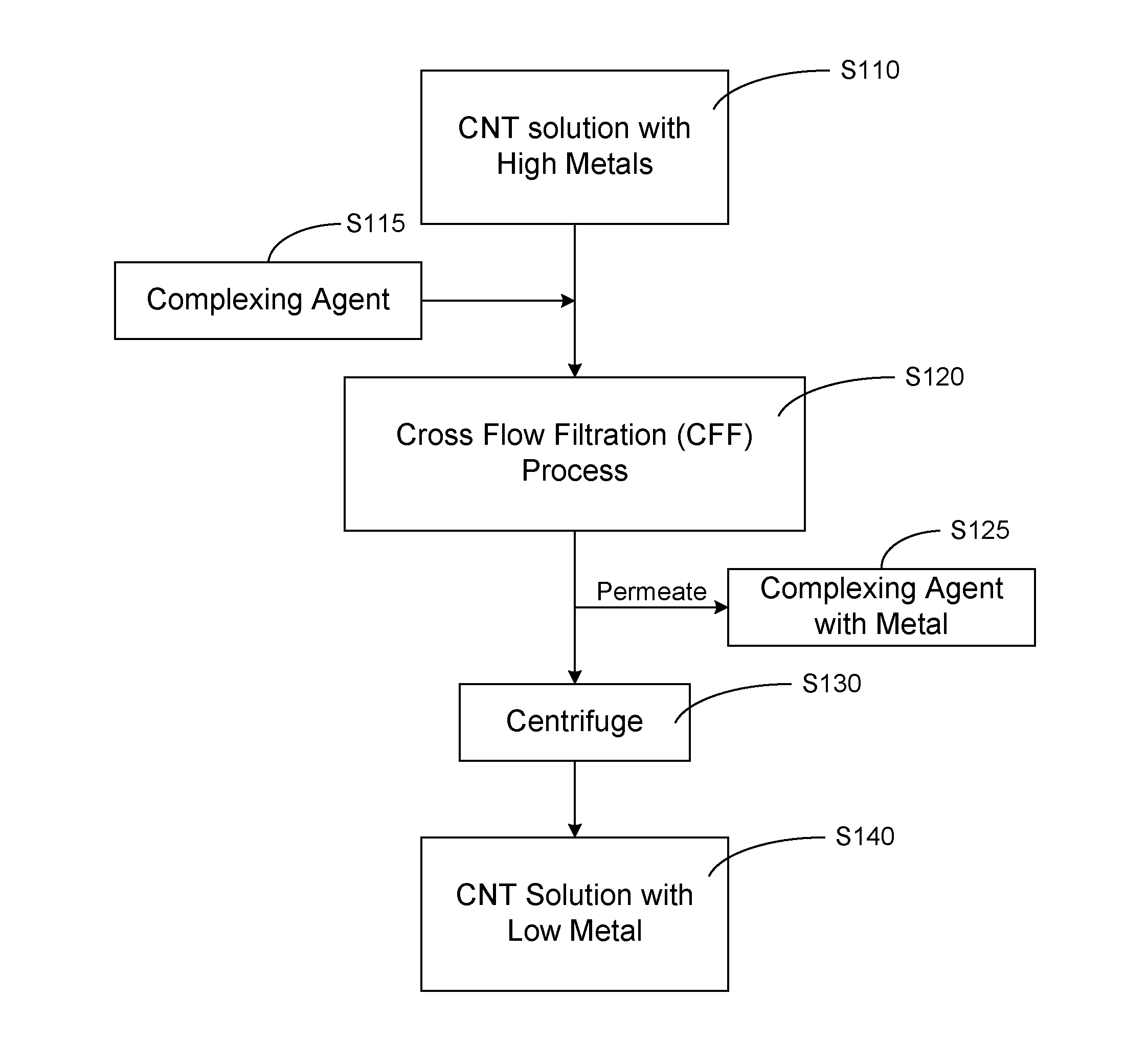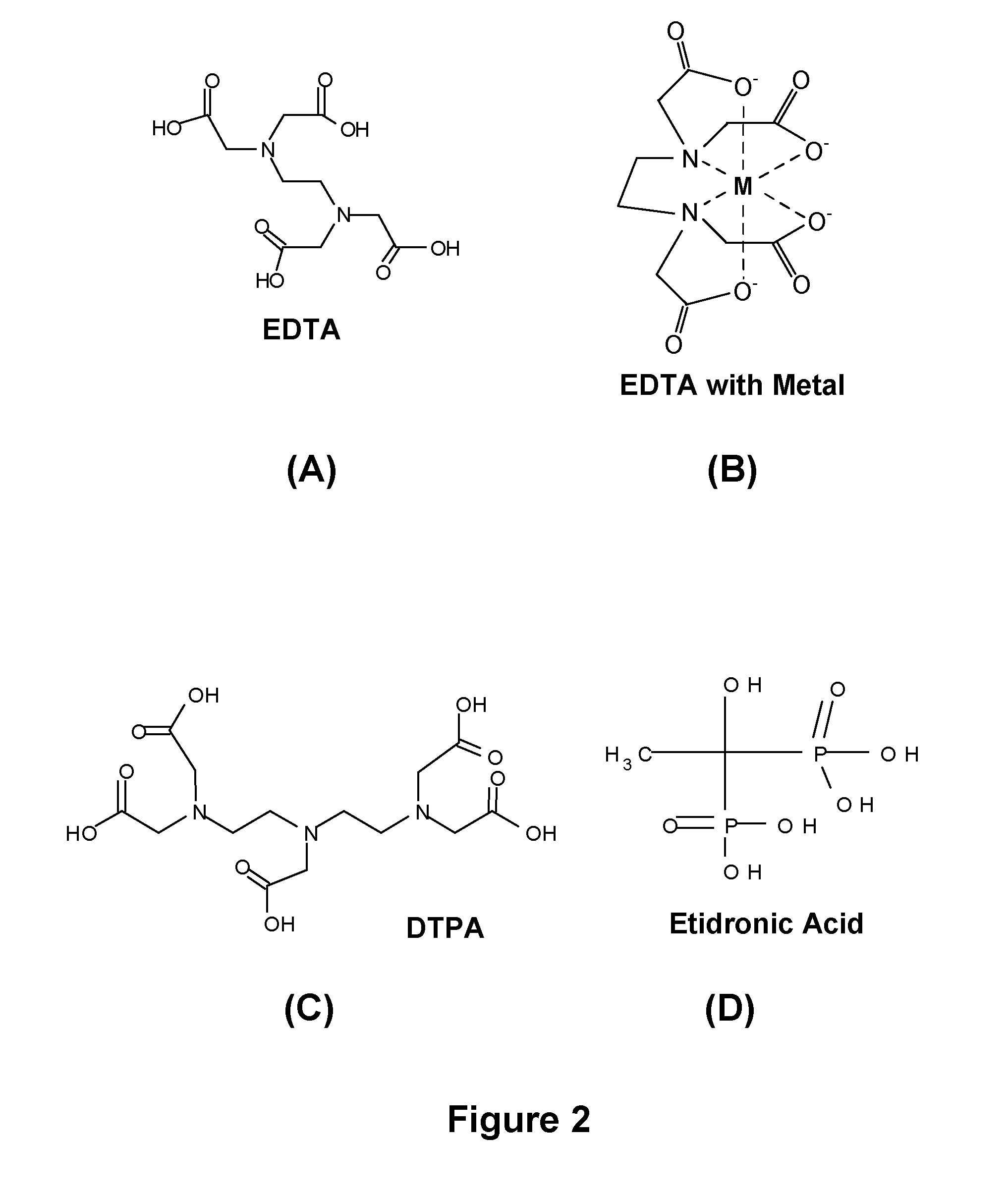Nanotube solutions with high concentration and low contamination and methods for purifiying nanotube solutions
a technology of nanotubes and nanotube solutions, applied in the direction of sedimentation separation, conductive materials, solid-state devices, etc., can solve the problems of difficult removal of derivatizing agents, difficult placement of catalyst particles and the growth of millions of properly aligned nanotubes of specific length, and high contamination of nanotube solutions, so as to achieve low contamination
- Summary
- Abstract
- Description
- Claims
- Application Information
AI Technical Summary
Benefits of technology
Problems solved by technology
Method used
Image
Examples
example 1
[0080]Referring to FIG. 1, there is illustrated a method for producing or purifying a CNT solution in accordance with one embodiment consistent with the present disclosure. While different contaminants may be removed in one or more steps consistent with the present disclosure, this particular example focuses on a method that can remove metal contaminants from the CNT solution.
[0081]In Step S110, a first CNT solution is provided. The first CNT solution may be prepared by dispersing acid oxidized CNT raw materials in water. In one embodiment, the first CNT solution is contained in a stainless steel container. The first CNT solution may be treated with the above acid and / or base treatments, and thus have a reduced amount of metal impurities. Although the first CNT solution may have been treated with acid and / or base, the first CNT solution is considered to include a high level of metal impurities. In one embodiment, metal impurities of more than 25 ppb by wt. for CNT solution is consid...
example 2
[0096]Referring to FIG. 4, there is illustrated a method for producing or purifying a solution of carbon nanotubes in accordance with another embodiment consistent with the present disclosure. While different contaminants may be removed in one or more process steps consistent with the present disclosure, this particular example focuses on a method that can remove amorphous carbon from the CNT solution.
[0097]In Step S410, a first CNT solution is provided. The first CNT solution may be prepared by dispersing CNT raw materials in water. The first CNT solution may be treated with the acid and / or base treatments described above and may have undergone conventional filtration and / or centrifugation processes. Accordingly, the first CNT solution may already have a reduced amount of amorphous carbon. However, the first CNT solution may still be considered as having a high level of amorphous carbon, because many amorphous carbon are attracted by the nanotube elements through the van der Waals ...
example 3
[0104]FIGS. 5 and 6 illustrate methods for producing or purifying a solution of carbon nanotubes in accordance with embodiments consistent with the present disclosure. While different contaminants may be removed in one or more process steps consistent with the present disclosure, this particular example focuses on methods that can remove silica particles from the CNT solution.
[0105]Referring first to FIG. 5, a CNT raw material (or a CNT starting material) is provided in Step S510. The CNT raw material normally contains silica particles in an amount significantly beyond the acceptable range. Accordingly, it is desirable to remove these silica particles.
[0106]In Step S520, the CNT raw material may be treated with a nitric acid so as to disperse or dissolve the CNT raw materials in water, thereby forming a first CNT solution. In Step S530, a first filtration process, such as a first cross flow filtration (CFF1) process, may be performed to the first CNT solution. The first filtration p...
PUM
| Property | Measurement | Unit |
|---|---|---|
| Temperature | aaaaa | aaaaa |
| Fraction | aaaaa | aaaaa |
| Pore size | aaaaa | aaaaa |
Abstract
Description
Claims
Application Information
 Login to View More
Login to View More - R&D
- Intellectual Property
- Life Sciences
- Materials
- Tech Scout
- Unparalleled Data Quality
- Higher Quality Content
- 60% Fewer Hallucinations
Browse by: Latest US Patents, China's latest patents, Technical Efficacy Thesaurus, Application Domain, Technology Topic, Popular Technical Reports.
© 2025 PatSnap. All rights reserved.Legal|Privacy policy|Modern Slavery Act Transparency Statement|Sitemap|About US| Contact US: help@patsnap.com



